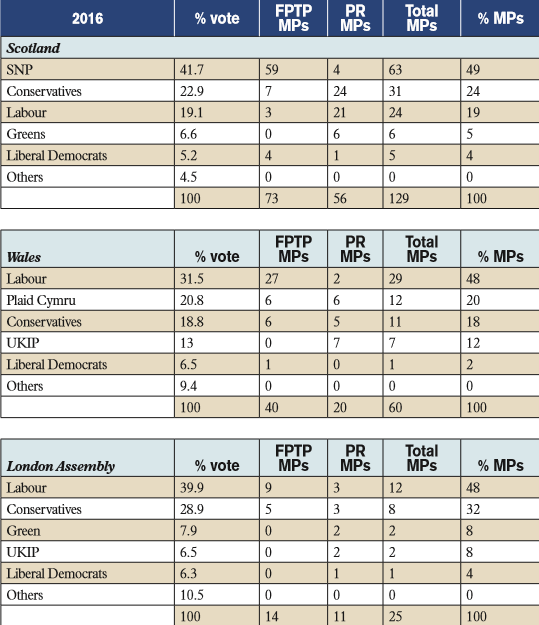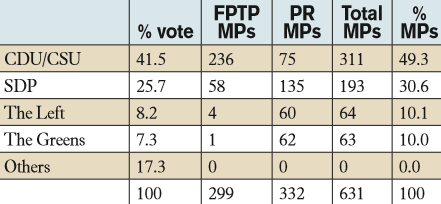Publicité
Who should win elections in a mixed electoral system ? Recent lessons from Scotland, Wales and London
Par
Partager cet article
Who should win elections in a mixed electoral system ? Recent lessons from Scotland, Wales and London

THE PLAIN answer to this question from Scotland, Wales and London is a resounding: SHARE OF NATIONAL VOTE POLLED. In essence, the allocation of seats in a mixed electoral system should mirror the wishes of the people, not the quirkness or the perversion of a voting formula.
The Ministerial Committee on electoral reform will have to crack this tough nut when making recommendations on introducing a dose of PR (Editor’s Note: Proportional Representation) in the current FPTP (Editor’s Note: First Past The Post) voting formula. Unlike what is universal practice on how to designate the winner in a mixed FPTP/ PR electoral system, some in Mauritius (and Rodrigues) would like to disregard the share of popular vote in allocating PR seats. Instead they want the winner of the FPTP mode of the mixed FPTP/PR system to be favoured and to win the overall electoral contest, irrespective of the share of national vote polled by that party.
Obviously and rightly there is no country with a mixed electoral system that provides such a guarantee. As clearly shown in the election results to the Scottish Parliament, the Welsh Assembly and the London Assembly earlier this month, whether the winner of the FPTP contest emerges as the overall winner after the allotment of the PR seats depends crucially on the percentage of national vote polled by that party.
All three UK regions operate a mixed FPTP/PR voting system, albeit with varying dosages. Scotland has 73 FPTP and 56 PR seats; Wales has 40 FPTP and 20 PR elected members while the London Assembly returns 14 FPTP and 11 PR representatives. While the split between the two modes will certainly affect the final outcome, the principle of who should be the winner remains the same. It is an emphatic SHARE OF NATIONAL VOTE.

Elections were held recently in these three regions and the outcome was as follows (see table above).
In Scotland, the SNP took 59 of the 73 constituency seats, thus gaining a thumping FPTP majority of 45 members. However as it polled only 41.7% of the national vote, it secured only 4 PR seats as the allotment is carried out on the basis of a compensatory method as per Model C of the Sachs commission. Overall it obtained 63 of the 129 seats, which is shy of the overall majority of 65. Thus, a very huge FPTP majority has been transformed into a hung Parliament because of the share of vote of the SNP. It should be pointed out that it is not necessary to have 50 % of the vote for an overall majority. In the outgoing Parliament, the SNP had a working majority with 69 seats on 44% of the popular vote;
In Wales, the Labour Party captured 27 of the 40 FPTP seats, thus securing an important FPTP majority of 14 MPs. However, as it polled only 31.5% of the national suffrage, it was allocated only 2 PR seats and ended up with a total of 29 MPs in an Assembly of 60 seats. Again it is a hung Parliament due to the low share of Labour vote. There will either be a coalition government or a minority one. This is clearly the wish of the people as echoed by the vote distribution;
In London, Labour won 9 of the 14 constituency seats with a FPTP majority of 4 members. However with only 39.9% of the London-wide vote, it could not hold on to its majority after the allocation of the 11 PR seats. It took 12 out of the 25 seats after the 11 PR members were returned;
There is a premium for the winner in the mixed system. For instance, in Scotland, the SNP took 49% of seats on 41.7% of national vote, in Wales Labour captured 48% of seats on 31.5% of votes while Labour won 48.8% of seats with 39.9% of vote in London. However it is not as high and dramatic as in the case of a stand alone FPTP formula. The SNP took 81% of the 73 FPTP seats on only 46.5% of the constituency votes while Labour bagged 67.5% of the 40 FPTP seats in Wales on 34.7% of constituency votes. It should be noted that there are two votes in these regions, one for constituency MPs and one for party list.
“Ultimately it is the share of popular vote that determines the result of the election.”
The lessons are very clear.
The winner in a mixed FPTP/PR electoral system can only be ascertained after the allocation of both FPTP and PR seats. Whether the party that has an absolute majority in the FPTP mode remains the overall winner after the distribution of the PR seats hinges crucially on its share of popular vote. The higher the percentage of that vote, the more likely that it will emerge with an overall majority. The lower its share of popular suffrage, the less likely its chance of retaining that majority;
The share of vote and not the quirkness on an electoral system determines the allocation of seats. There is also no constitutional or legal ‘colourable device’ to create an artificial majority to favour the winner of the FPTP mode irrespective of its percentage of popular vote;
While it is possible to influence the final outcome of a mixed FPTP/PR electoral system by altering the split between FPTP and PR seats, by choosing a particular mathematical formula to return PR members, by playing with the vote threshold for eligibility to these PR seats, by having one set or two sets of vote and by proposing a regional or a national system to award seats, the fact remains that ultimately it is the share of popular vote that determines the result of the election. And there is absolutely no special rule to favour the winner of the FPTP contest irrespective of its vote share.
This is not a British peculiarity. It is the standard practice in countries that operate a mixed FPTP/PR system. In New Zealand and in Lesotho, there is no special provision to favour a party in the allocation of PR seats. It simply depends on the percentage of vote polled by each party. Germany also operates a mixed FPTP/PR voting system with 50% of seats in each mode. The results of the last general elections held in 2013 were as follows The CDU/CSU led by Mrs Merkel captured 236 of the 299 constituency seats with a huge FPTP majority of 173 members. However as it polled 41.5% of the national votes, it could not secure enough PR seats to preserve its overall majority. It ended up with 311 seats out of a total of 631. The premium of 7.8% between seats won and vote polled by CDU/CSU was not enough to have an overall majority. The results were accepted and Mrs Merkel had to enter into a grand coalition with the SDP to govern the country.

The same pattern exists in Lesotho, a SADC country with a Westminster-type system which has embraced a mixed FPTP-PR voting formula with 80 FPTP and 40 PR seats. In the 2015 elections, the party that won the FPTP electoral mode could not retain its lead after the distribution of PR seats as it took only 37.7% of national vote.
Some stakeholders have raised the issue that the allocation of the PR seats should not frustrate the FPTP choice of the electorate. It would be almost impossible to guarantee such a result except where the FPTP winner has polled at least around 45% of the votes.
What would be the purpose of injecting a dose of PR in the system if its impact is immediately reversed by the introduction of a clause that the outcome of the FPTP will anyway prevail? As well stated by the Select Committee of 2002 chaired by I. Collendavelloo;
“At the end of the day, we need to know what we want. It does appear incongruous to clamour against the unfairness of the present system and we agree that we require a dose of PR to mitigate the rigours of the system. We ought not therefore to be surprised when a dose of PR precisely achieves this result.”
It went on to argue that
“There is no conversion of a “majority” into a minority since the final results only serve to proclaim the reality of the vote and not the contingency of an unfair system where the minority becomes the majority”.
It stands to democratic reason that the winner can only be determined after both sets of seats – FPTP and PR – are allotted. It would not make sense to condition the final outcome on the result of elections in one mode only. There is no country with a mixed FPTP/PR system that operates on that basis. One can only hope that the recommendations of the Ministerial committee will be wisely informed by what obtains in other countries with a mixed FPTP/PR voting formula. It is the share of popular vote that should prevail.
Publicité
Publicité
Les plus récents






